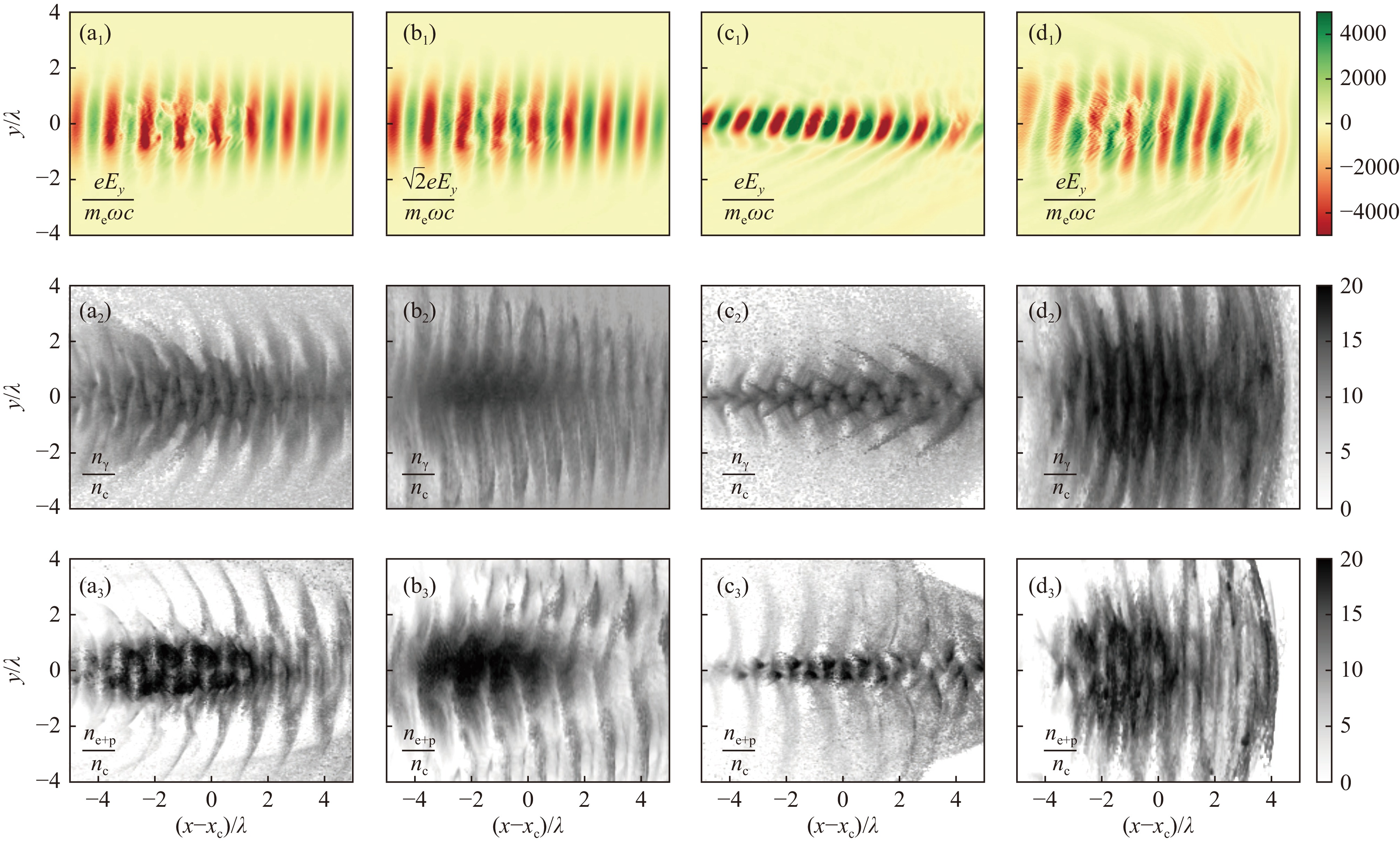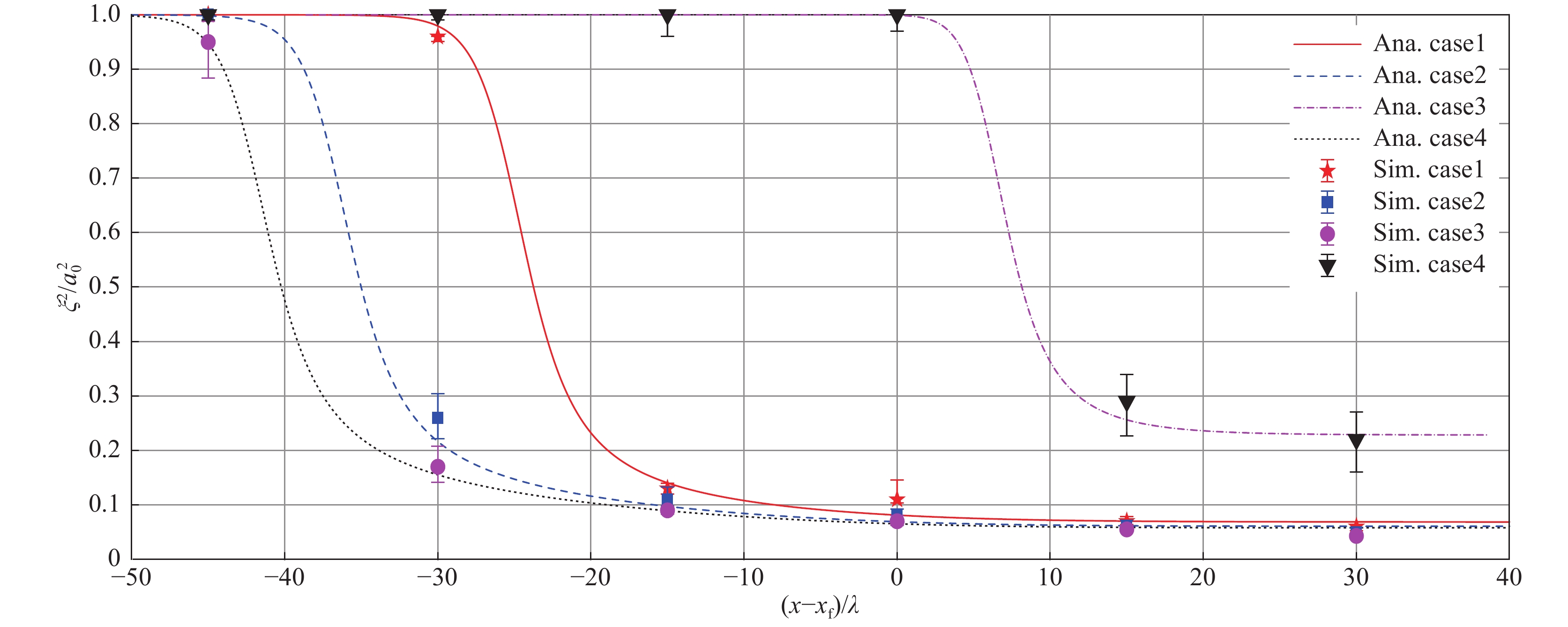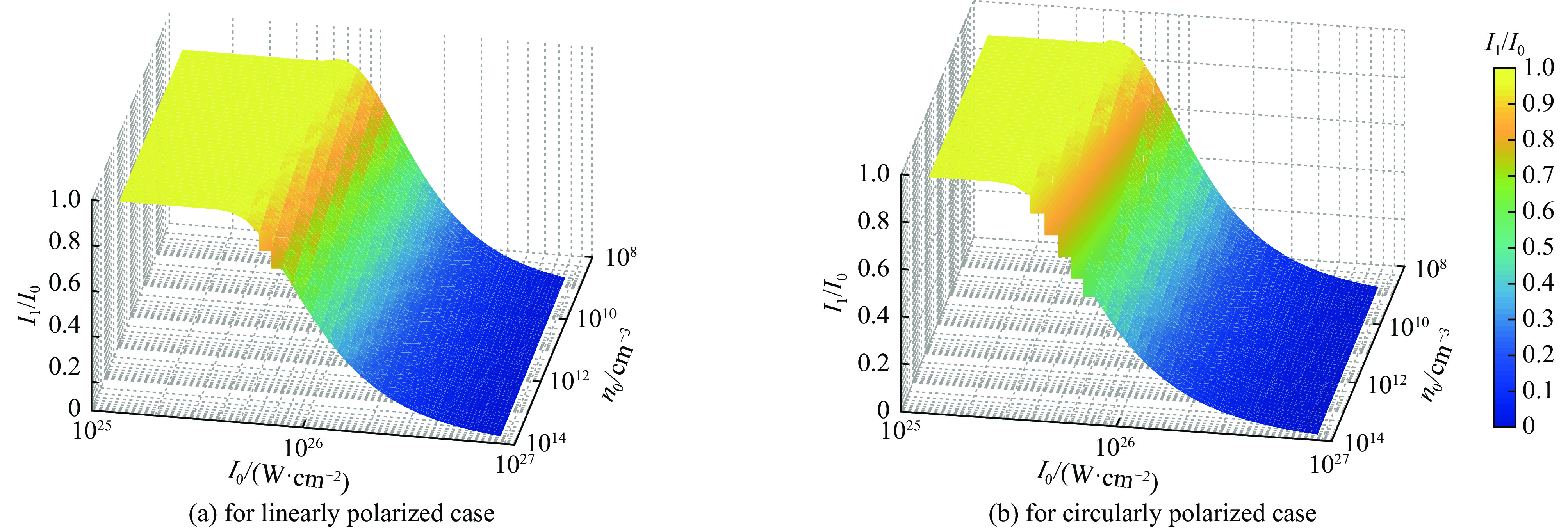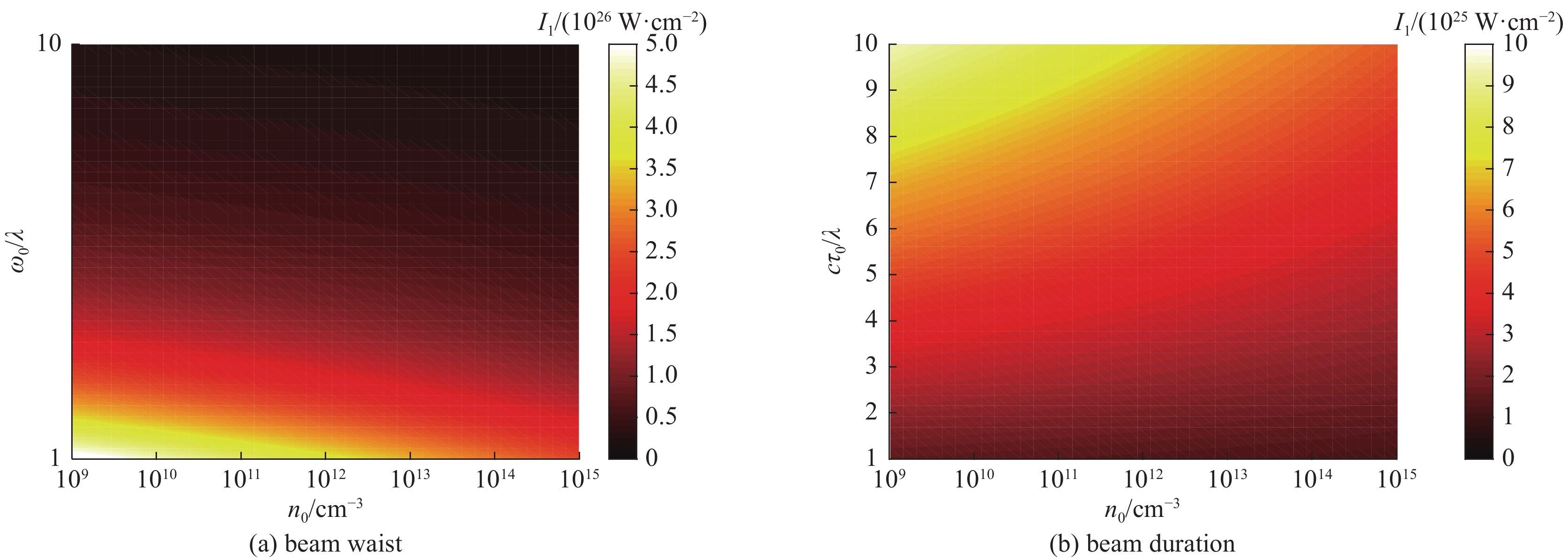Impact of laser parameters on attainable upper limit of laser intensity in non-ideal vacuum
-
摘要: 人类在实验室可实现的激光强度极限是强场量子电动力学(QED)的重要问题。在非理想真空条件下,极端超强激光与残留的电子相互作用触发伽马光子辐射与正负电子对产生的QED级联效应,从而显著消耗激光能量,大幅降低可实现的激光峰值强度。考虑到QED级联效应与激光偏振、焦斑尺寸、脉宽长度有着密切的关系,基于囊括QED过程的粒子网格模拟方法(Particle-in-cell, PIC)对上述参数的效应进行分析,同时构建了激光场演化的自洽方程来进行解释,二者结果基本保持一致,获得的强度极限在考虑的参数范围内为1026~1027 W/cm−2。结果表明,同等情形下,圆偏振激光可激发更强的QED级联,使得激光强度上限略低于线偏振。此外,紧聚焦激光由于QED级联发生的时空间尺度更小,从而激光的吸收效应被显著抑制,进而可以实现更强的聚焦强度。对于更长脉宽的激光,由于正负电子对吸收的能量区域更加弥散,使得可实现的激光强度上限阈值有所提升。但对于超短脉宽情形(如单周期),由于QED级联的种子源电子束不能很好地被约束在激光区域,理论分析耗散的激光能量偏高。此外,在高真空度的情形下,残余电子的随机性也会对可实现激光强度产生一定的影响。研究结果可为后续开展极端强场QED实验和数100 PW级超强超短激光装置建设提供指导。
-
关键词:
- 激光极限强度 /
- 强场量子电动力学 /
- 量子电动力学级联效应 /
- 激光等离子体相互作用 /
- PIC模拟
Abstract: The attainable upper limit of the laser intensity is a key concern in strong-field quantum electrodynamics (QED). For non-ideal vacuum conditions, the extreme laser fields interacting with the residual electrons could trigger QED cascade—the processes of gamma-photon emission and electron-positron pair production. It leads to strong depletion of the laser pulse hence limits the attainable laser intensity. Since the QED cascade is affected by the polarization, beam waist and duration of the laser pulse, we investigate the effects of these parameters based on particle-in-cell (PIC) simulations incorporating the QED modules. We also develop self-consistent dynamics equations to describe the laser depletion process, which agree well with the PIC simulations. According to the analysis, the upper limit of attainable intensity is about 1026−1027 W/cm−2 in the considered parameter range. Specifically, the circularly polarized pulses drive stronger QED cascade than in the linearly polarized case under the same circumstances, resulting lower upper limit threshold of intensity. In addition, tightly focused lasers correspond to smaller cascade durations and interaction volumes. Thus, the absorption of laser energy is inhibited, i.e., higher peak intensity can be achieved. Regarding the effect of pulse duration, the depletion energy will be dispersed along larger absorption volume so that the attainable intensity will be enhanced. It should be noted that for extremely short pulses (single cycle), the seeded particles of QED cascade (i.e., electrons and positrons) cannot be efficiently trapped in the laser field, and the analytical model tends to overrate the absorption of laser energy. Regarding the extreme low purity case (i.e., the low electron residual density), the stochastic position of the residual electrons will strongly affect the upper limit of the intensity. Overall, these results offer a guideline for further experiment setups of exploring strong field QED processes and construction of the state-of-art hundred-petawatt laser facilities. -
图 3 基于式(8)和PIC模拟得到的归一化强度
$ {\xi }^{2}/{a}_{0}^{2} $ 在不同情形下的演化结果,其中情形1~4分别对应于图2(a)~图2(d)的四种情况Figure 3. Normalized peak intensity
$ {\xi }^{2}/{a}_{0}^{2} $ evolution from analytical calculation based on Eq. (8) and PIC simulations, where the cases 1~4 represent the parameters of Fig.2(a)~Fig. 2(d), respectively图 4 激光极限强度与不同偏振下真空残余电子密度、τ0=5λ/c的线偏情况下焦斑大小以及在ω0=3λ的线偏情形下激光脉宽的关系
Figure 4. Attainable peak intensity I1 as a function of vacuum electron residual density for linearly and circularly polarized pulse with τ0=5λ/c, ω0=3λ, waist of laser for linearly polarized pulse with τ0=5λ/c and duration of the laser for linearly polarized pulse with ω0=3λ
-
[1] Tajima T, Dawson J M. Laser electron accelerator[J]. Physical Review Letters, 1979, 43(4): 267-270. doi: 10.1103/PhysRevLett.43.267 [2] Faure J, Glinec Y, Pukhov A, et al. A laser–plasma accelerator producing monoenergetic electron beams[J]. Nature, 2004, 431(7008): 541-544. doi: 10.1038/nature02963 [3] Geddes C G R, Toth C, Van Tilborg J, et al. High-quality electron beams from a laser wakefield accelerator using plasma-channel guiding[J]. Nature, 2004, 431(7008): 538-541. doi: 10.1038/nature02900 [4] Mangles S P D, Murphy C D, Najmudin Z, et al. Monoenergetic beams of relativistic electrons from intense laser–plasma interactions[J]. Nature, 2004, 431(7008): 535-538. doi: 10.1038/nature02939 [5] Clayton C E, Ralph J E, Albert F, et al. Self-guided laser wakefield acceleration beyond 1 GeV using ionization-induced injection[J]. Physical Review Letters, 2010, 105: 105003. doi: 10.1103/PhysRevLett.105.105003 [6] Gonsalves A J, Nakamura K, Daniels J, et al. Petawatt laser guiding and electron beam acceleration to 8 GeV in a laser-heated capillary discharge waveguide[J]. Physical Review Letters, 2019, 122: 084801. doi: 10.1103/PhysRevLett.122.084801 [7] 陈民, 盛政明, 郑君, 等. 强激光与高密度气体相互作用中电子和离子加速的数值模拟[J]. 物理学报, 2006, 55(5):2381-2388 doi: 10.3321/j.issn:1000-3290.2006.05.044Chen Min, Sheng Zhengming, Zheng Jun, et al. Numerical simulation of acceleration of electrons and ions in the interaction of intense laser pulses with dense gaseous targets[J]. Acta Physica Sinica, 2006, 55(5): 2381-2388 doi: 10.3321/j.issn:1000-3290.2006.05.044 [8] 蒋康男, 冯珂, 柯林佟, 等. 高品质激光尾波场电子加速器[J]. 物理学报, 2021, 70:084103 doi: 10.7498/aps.70.20201993Jiang Kangnan, Feng Ke, Ke Lintong, et al. High-quality laser wakefield electron accelerator[J]. Acta Physica Sinica, 2021, 70: 084103 doi: 10.7498/aps.70.20201993 [9] Higginson A, Gray R J, King M, et al. Near-100 MeV protons via a laser-driven transparency-enhanced hybrid acceleration scheme[J]. Nature Communications, 2018, 9: 724. doi: 10.1038/s41467-018-03063-9 [10] Hegelich B M, Albright B J, Cobble J, et al. Laser acceleration of quasi-monoenergetic MeV ion beams[J]. Nature, 2006, 439(7075): 441-444. doi: 10.1038/nature04400 [11] Wang Wentao, Feng Ke, Ke Lintong, et al. Free-electron lasing at 27 nanometres based on a laser wakefield accelerator[J]. Nature, 2021, 595(7868): 516-520. doi: 10.1038/s41586-021-03678-x [12] Xu Tongjun, Shen Baifei, Xu Jiancai, et al. Ultrashort megaelectronvolt positron beam generation based on laser-accelerated electrons[J]. Physics of Plasmas, 2016, 23: 033109. doi: 10.1063/1.4943280 [13] Emma C, Van Tilborg J, Assmann R, et al. Free electron lasers driven by plasma accelerators: status and near-term prospects[J]. High Power Laser Science and Engineering, 2021, 9: e57. doi: 10.1017/hpl.2021.39 [14] Phuoc K T, Corde S, Thaury C, et al. All-optical Compton gamma-ray source[J]. Nature Photonics, 2012, 6(5): 308-311. doi: 10.1038/nphoton.2012.82 [15] Clark E L, Grigoriadis A, Petrakis S, et al. High-intensity laser-driven secondary radiation sources using the ZEUS 45 TW laser system at the Institute of Plasma Physics and Lasers of the Hellenic Mediterranean University Research Centre[J]. High Power Laser Science and Engineering, 2021, 9: e53. doi: 10.1017/hpl.2021.38 [16] Nie Zan, Pai C H, Zhang Jie, et al. Photon deceleration in plasma wakes generates single-cycle relativistic tunable infrared pulses[J]. Nature Communications, 2020, 11: 2787. doi: 10.1038/s41467-020-16541-w [17] Zhang Meng, Chu Yuxi, Zhao Jun, et al. Efficient generation of third harmonics in Yb-doped femtosecond fiber laser via spatial and temporal walk-off compensation[J]. Chinese Optics Letters, 2021, 19: 031402. doi: 10.3788/COL202119.031402 [18] Betti R, Hurricane O A. Inertial-confinement fusion with lasers[J]. Nature Physics, 2016, 12(5): 435-448. doi: 10.1038/nphys3736 [19] Tabak M, Hinkel D, Atzeni S, et al. Fast ignition: overview and background[J]. Fusion Science and Technology, 2006, 49(3): 254-277. doi: 10.13182/FST49-3-254 [20] Mima K. 惯性聚变能研究现状[J]. 罗山, 译. 激光与光电子学进展, 2004, 41(1):3-11Mima K. Research status of inertial fusion energy[J]. Luo Shan, Ttranslated. Laser & Optoelectronics Progress., 2004, 41(1): 3-11 [21] Cristoforetti G, Hüller S, Koester P, et al. Observation and modelling of stimulated Raman scattering driven by an optically smoothed laser beam in experimental conditions relevant for Shock Ignition[J]. High Power Laser Science and Engineering, 2021, 9: e60. doi: 10.1017/hpl.2021.48 [22] Zhang F, Cai Hongbo, Zhou Weimin, et al. Enhanced energy coupling for indirect-drive fast-ignition fusion targets[J]. Nature Physics, 2020, 16(7): 810-814. doi: 10.1038/s41567-020-0878-9 [23] Takabe H, Kuramitsu Y. Recent progress of laboratory astrophysics with intense lasers[J]. High Power Laser Science and Engineering, 2021, 9: e49. doi: 10.1017/hpl.2021.35 [24] Casner A, Caillaud T, Darbon S, et al. LMJ/PETAL laser facility: overview and opportunities for laboratory astrophysics[J]. High Energy Density Physics, 2015, 17: 2-11. doi: 10.1016/j.hedp.2014.11.009 [25] 张杰, 赵刚. 实验室天体物理学简介[J]. 物理, 2000, 29(7):393-396 doi: 10.3321/j.issn:0379-4148.2000.07.003Zhang Jie, Zhao Gang. Introduction to laboratory astrophysics[J]. Physics, 2000, 29(7): 393-396 doi: 10.3321/j.issn:0379-4148.2000.07.003 [26] Ji Liangliang, Pukhov A, Kostyukov I Y, et al. Radiation-reaction trapping of electrons in extreme laser fields[J]. Physical Review Letters, 2014, 112: 145003. doi: 10.1103/PhysRevLett.112.145003 [27] Poder K, Tamburini M, Sarri G, et al. Experimental signatures of the quantum nature of radiation reaction in the field of an ultraintense laser[J]. Physical Review X, 2018, 8: 031004. [28] Cole J M, Behm K T, Gerstmayr E, et al. Experimental evidence of radiation reaction in the collision of a high-intensity laser pulse with a laser-wakefield accelerated electron beam[J]. Physical Review X, 2018, 8: 011020. [29] Zhu Xinglong, Yu Tongpu, Sheng Zhengming, et al. Dense GeV electron–positron pairs generated by lasers in near-critical-density plasmas[J]. Nature Communications, 2016, 7: 13686. doi: 10.1038/ncomms13686 [30] Zhu Xinglong, Chen Min, Weng Suming, et al. Extremely brilliant GeV γ-rays from a two-stage laser-plasma accelerator[J]. Science Advances, 2020, 6: eaaz7240. doi: 10.1126/sciadv.aaz7240 [31] Zhu Xinglong, Chen Min, Yu Tongpu, et al. Collimated GeV attosecond electron–positron bunches from a plasma channel driven by 10 PW lasers[J]. Matter and Radiation at Extremes, 2019, 4: 014401. doi: 10.1063/1.5083914 [32] Strickland D, Mourou G. Compression of amplified chirped optical pulses[J]. Optics Communications, 1985, 55(6): 447-449. doi: 10.1016/0030-4018(85)90151-8 [33] Yoon J W, Kim Y G, Choi I W, et al. Realization of laser intensity over 1023 W/cm2[J]. Optica, 2021, 8(5): 630-635. doi: 10.1364/OPTICA.420520 [34] Bahk S W, Rousseau P, Planchon T A, et al. Characterization of focal field formed by a large numerical aperture paraboloidal mirror and generation of ultra-high intensity (1022 W/cm2)[J]. Applied Physics B, 2005, 80(7): 823-832. doi: 10.1007/s00340-005-1803-8 [35] Bahk S W, Rousseau P, Planchon T A, et al. Generation and characterization of the highest laser intensities (1022 W/cm2)[J]. Optics Letters, 2004, 29(24): 2837-2839. doi: 10.1364/OL.29.002837 [36] Guo Zhen, Yu Lianghong, Wang Jianye, et al. Improvement of the focusing ability by double deformable mirrors for 10-PW-level Ti: sapphire chirped pulse amplification laser system[J]. Optics Express, 2018, 26(20): 26776-26786. doi: 10.1364/OE.26.026776 [37] Danson C N, Haefner C, Bromage J, et al. Petawatt and exawatt class lasers worldwide[J]. High Power Laser Science and Engineering, 2019, 7: e54. doi: 10.1017/hpl.2019.36 [38] 冷雨欣. 上海超强超短激光实验装置[J]. 中国激光, 2019, 46:0100001 doi: 10.3788/CJL201946.0100001Leng Yuxin. Shanghai superintense ultrafast laser facility[J]. Chinese Journal of Lasers, 2019, 46: 0100001 doi: 10.3788/CJL201946.0100001 [39] Zhang Zongxin, Wu Fenxiang, Hu Jiabing, et al. The 1 PW/0.1Hz laser beamline in SULF facility[J]. High Power Laser Science and Engineering, 2020, 8: e4. doi: 10.1017/hpl.2020.3 [40] Peng Yujie, Xu Yi, Yu Lianghong, et al. Overview and status of station of extreme light toward 100 PW[J]. Reza Kenkyu, 2021, 49(2): 93-96. [41] Cartlidge E. Physicists are planning to build lasers so powerful they could rip apart empty space[J/OL]. Science, (2018-01-25). https://www.science.org/content/article/physicists-are-planning-build-lasers-so-powerful-they-could-rip-apart-empty-space. [42] Zamfir V, Tanaka K, Ur C. Extreme light infrastructure nuclear physics (ELI-NP)[J]. Europhysics News, 2019, 50(2): 23-25. doi: 10.1051/epn/2019204 [43] Grittani G, Lazzarini C, Lorenz S, et al. ELI-ELBA: fundamental science investigations with high power lasers at ELI-Beamlines[C]//OSA High-brightness Sources and Light-driven Interactions Congress 2020. Optical Society of America, 2020: JM3A. 20. [44] Papadopoulos D N, Zou J P, Le Blanc C, et al. The Apollon 10 PW laser: experimental and theoretical investigation of the temporal characteristics[J]. High Power Laser Science and Engineering, 2016, 4: e34. doi: 10.1017/hpl.2016.34 [45] Musgrave I, Galimberti M, Boyle A, et al. Review of laser diagnostics at the Vulcan laser facility[J]. High Power Laser Science and Engineering, 2015, 3: e26. doi: 10.1017/hpl.2015.27 [46] American Association for the Advancement of Science. So much more to know…[J]. Science, 2005, 309(5731): 78-102. [47] Bell A R, Kirk J G. Possibility of prolific pair production with high-power lasers[J]. Physical Review Letters, 2008, 101: 200403. doi: 10.1103/PhysRevLett.101.200403 [48] Kirk J G, Bell A R, Arka I. Pair production in counter-propagating laser beams[J]. Plasma Physics and Controlled Fusion, 2009, 51: 085008. doi: 10.1088/0741-3335/51/8/085008 [49] Fedotov A M, Narozhny N B, Mourou G, et al. Limitations on the attainable intensity of high power lasers[J]. Physical Review Letters, 2010, 105: 080402. doi: 10.1103/PhysRevLett.105.080402 [50] Schwinger J. Particles, sources, and fields Vol. 3[M]. Reading: Advanced Book Program, 1998. [51] Fedotov A M. Electron-positron pair creation by a strong tightly focused laser field[J]. Laser Physics, 2009, 19(2): 214-221. doi: 10.1134/S1054660X09020108 [52] Bulanov S S, Narozhny N B, Mur V D, et al. Electron-positron pair production by electromagnetic pulses[J]. Journal of Experimental and Theoretical Physics, 2006, 102(1): 9-23. doi: 10.1134/S106377610601002X [53] Wu Yitong, Ji Liangliang, Li Ruxin. On the upper limit of laser intensity attainable in nonideal vacuum[J]. Photonics Research, 2021, 9(4): 541-547. doi: 10.1364/PRJ.416555 [54] Bashmakov V F, Nerush E N, Kostyukov I Y, et al. Effect of laser polarization on quantum electrodynamical cascading[J]. Physics of Plasmas, 2014, 21: 013105. doi: 10.1063/1.4861863 [55] Tamburini M, Di Piazza A, Keitel C H. Laser-pulse-shape control of seeded QED cascades[J]. Scientific Reports, 2017, 7: 5694. doi: 10.1038/s41598-017-05891-z [56] Sampath A, Tamburini M. Towards realistic simulations of QED cascades: non-ideal laser and electron seeding effects[J]. Physics of Plasmas, 2018, 25: 083104. doi: 10.1063/1.5022640 [57] Luo Wen, Liu Weiyuan, Yuan Tao, et al. QED cascade saturation in extreme high fields[J]. Scientific Reports, 2018, 8: 8400. doi: 10.1038/s41598-018-26785-8 [58] Elkina N V, Fedotov A M, Kostyukov I Y, et al. QED cascades induced by circularly polarized laser fields[J]. Physical Review Accelerators and Beams, 2011, 14: 054401. doi: 10.1103/PhysRevSTAB.14.054401 [59] Bulanov S S, Schroeder C B, Esarey E, et al. Electromagnetic cascade in high-energy electron, positron, and photon interactions with intense laser pulses[J]. Physical Review A, 2013, 87: 062110. doi: 10.1103/PhysRevA.87.062110 [60] Grismayer T, Vranic M, Martins J L, et al. Seeded QED cascades in counterpropagating laser pulses[J]. Physical Review E, 2017, 95: 023210. doi: 10.1103/PhysRevE.95.023210 [61] Jirka M, Klimo O, Vranic M, et al. QED cascade with 10 PW-class lasers[J]. Scientific Reports, 2017, 7: 15302. doi: 10.1038/s41598-017-15747-1 [62] Samsonov A S, Kostyukov I Y, Nerush E N. Hydrodynamical model of QED cascade expansion in an extremely strong laser pulse[J]. Matter and Radiation at Extremes, 2021, 6: 034401. doi: 10.1063/5.0035347 [63] Hartemann F V, Kerman A K. Classical theory of nonlinear Compton scattering[J]. Physical Review Letters, 1996, 76(4): 624-627. doi: 10.1103/PhysRevLett.76.624 [64] Breit G, Wheeler J A. Collision of two light quanta[J]. Physical Review Journals Archive, 1934, 46(12): 1087-1091. [65] Reiss H R. Absorption of light by light[J]. Journal of Mathematical Physics, 1962, 3(1): 59-67. doi: 10.1063/1.1703787 [66] Nikishov A I, Ritus V I. Quantum processes in the field of a plane electromagnetic wave and in a constant field. I[J]. Soviet Physics JETP, 1964, 19(2): 529-541. [67] Baier V N, Katkov V M, Fadin V S. Radiation of relativistic electrons; Izluchenie relyativistskikh elektronov[M]. Moscow: Atomizdat, 1973. [68] Ritus V I. Quantum effects of the interaction of elementary particles with an intense electromagnetic field[J]. Journal of Soviet Laser Research, 1985, 6(5): 497-617. doi: 10.1007/BF01120220 [69] Pukhov A. Three-dimensional electromagnetic relativistic particle-in-cell code VLPL (Virtual Laser Plasma Lab)[J]. Journal of Plasma Physics, 1999, 61(3): 425-433. doi: 10.1017/S0022377899007515 [70] Pukhov A. Particle-in-cell codes for plasma-based particle acceleration[C]//Proceedings of the 2014 CAS-CERN Accelerator School: Plasma Wake Acceleration. 2016. [71] Sokolov I V, Naumova N M, Nees J A. Numerical modeling of radiation-dominated and quantum-electrodynamically strong regimes of laser-plasma interaction[J]. Physics of Plasmas, 2011, 18: 093109. doi: 10.1063/1.3638138 [72] Zot'ev D B. Critical remarks on Sokolov's equation of the dynamics of a radiating electron[J]. Physics of Plasmas, 2016, 23: 093302. doi: 10.1063/1.4962692 [73] Wallin E, Gonoskov A, Marklund M. Effects of high energy photon emissions in laser generated ultra-relativistic plasmas: real-time synchrotron simulations[J]. Physics of Plasmas, 2015, 22: 033117. doi: 10.1063/1.4916491 -





 下载:
下载:








